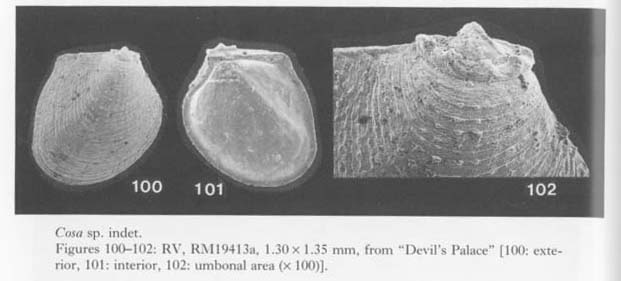Cosa sp. indet.
Figures 100-102

1991. Cosa (s. 1.) sp. 1. Kaneko, 1991, Venus, vol.50, p.158, fig.I.
This species is represented by only a few empty valves from the bottom sediments of "Devil's Palace" (RM19413) and "Lunch Hole" (RM19414) of Shimoji-Irabu Is-let, Miyako Islands.
In shape and size of shell it closely resembles Cosa waikikia from the same locality, but is distinguishable from that species in the more anteriorly located umbo, more prosoclinal ligament pit, entire valve margin, finely beaded radial ribs and coarsely frilled brim margin of Pd I. Unlike in other species of Cosa from Ryukyu Islands, the Pd I is slightly inclined forward, and its dorsal margin is considerably discordant with that of the adult shell (Figure 102).
On the other hand, all the observed features of this species are identical with those of an unnamed species, "Cosa (s. l.) sp. I", by Kaneko (1991, p.158, fig.I) from dredged sands of Okinawa Islands. These specimens as well as well as Kaneko's probably represent a new species, but the material at hand is still insufficient to propose a new name. It is also not clear whether this philobryid is an indigenous cryptic species or not.
Distribution.—The present species is, though rare, known in Okinawa and Miyako Islands, According to our preliminary observation, it occurs abundantly in "Balicasag Cave" off Panglao Islet of Bohol Island, the Philippines.
Genus Cratis Hedley, 1915
The genus Gratis has been represented by several lower sublittoral to bathyal spe-cies from Australia and New Zealand. Taxonomically, it has generally been treated as a group of the Philobryidae. Unlike Cosa and Philobrya, however, paedomorphic features are not very significant in Gratis; the denticles of provinculum are often restrictedly observed along the dorsal margin of Pd I, and a few anterior and posterior adult teeth occur on the hinge plate. As has been pointed out by Tevesz (1977) and some others, its similarity to some limopsids cannot be denied. For example, the genus Nipponolimopsis Habe, 1951 (type-species: Limopsis nipponica Yokoyama, 1922=Cyrilla decussata A. Adams, 1862) is, as noted by Habe (1977a), similar to Gratis in shell shape, surface ornamentation and hinge teeth. Limopsis dautzenbergi Prashad, 1932, from the Celebes Sea, may also be a member of Nipponolimopsis. The only marked differences between Gratis and Nipponolimopsis are the shell size and the size and shape of Pd I. Yet, as clarified by Tanabe (1990), an undoubted limopsid, Limopsis (Limopsis) azumana Yokoyama, 1910, from the Pleistocene of central Japan is non-planktotrophic, because it is characterized by large Pd I (ranging 400-450 µn) and absence of Pd II. The features of Pd I, as interpreted by Matsui (1991), may be plastic in accordance with reproductive strategy. These lines of evidence indicate that Gratis is an intermediate genus between the Philobryidae and the Limopsidae.